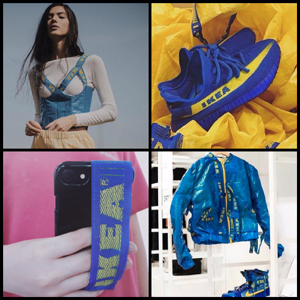By J’Net Nguyen
In April, Parisian fashion powerhouse Balenciaga released a $2,150 shopper carryall bag, which had the Internet roaring at its uncanny resemblance to IKEA’s 99-cent Frakta tote. With double handles, a similar vibrant blue, large silhouette, durable and multifunctional to hold all the day’s needs, plus some—The Internet exploded with commentary and memes overnight.
Immediately, IKEA’s response came through this cheeky digital ad, distributed through the brand’s social media accounts, that quickly went viral:
IKEA received a lot more attention for this tongue-in-cheek response than they could ever have anticipated. In fact, the brand’s iconic fashion sensibilities were celebrated globally, as clothing designers, online influencers and crafty fashionistas rushed to turn out industry–applauded creations inspired by the Swedish furniture retailer.
The Frakta tote also inspired designs from Fashion DIY’ers paying tribute to a wide range of venerable labels. Most notable creations included the Adidas Yeezy Boosts, based on a popular sneaker line commanding skyrocket resale prices and attracting legions of shoppers willing to camp outside of stores for days to guarantee their chance to purchase. Another paid homage to the much-coveted Hermes Birkin, the holy grail of handbags, which ranges in price from $10,000 to $150,000 – and has a waiting list!
So why is a Swedish furniture conglomerate, known for mass-produced affordable home goods, experiencing a loyal, cult-like following from the fashion elite to the underground cultural curators of the world?
First and foremost, IKEA is the epitome of cool.
In 2015, the brand teamed up alongside concept artist Martin Bergstrom and luxe British designer Katy Eary for Milan Fashion Week, merging interior design with apparel and creating a unique runway experience.
While this strategy may seem odd to an outsider, it makes perfect sense as fashion and décor have always played off one another and are closely linked. Apparel designers frequently acknowledge that their designs are influenced by architecture, furniture and interior. For example, Martin Bergstrom found pattern ideas in unconventional places likes distressed walls and hanging street cable. Similarly, one of modern fashion’s most iconic names, Tom Ford, studied interior architecture at The Parsons School of Design and credits his architectural foundation as the muse for many of his most prolific work. Crossover is also reflected by fashion brands such as Fendi, Versace and Gucci that produce home lines.
In the past few years, IKEA has pushed artistic and retail boundaries, successfully transcending their reputation as a go-to for students on budget. With limited edition designs, furniture collaborations with NASA, and other modern inspirations, IKEA is selling ambition and endless possibilities to young urban dwellers, living on their own for the first time.
Kanye West has publicly stated his interest in a design collaboration multiple times. On BBC Radio 1, he said, “I have to work with IKEA—make furniture for interior design, for architecture.” A deal was announced a year later with a Virgil Abloh partnership, West’s famed creative director and formally trained architect/civil engineer, who founded Milan-based label Off-White, a high-end label fusing street with high fashion.
This is all in line with IKEA’s dedication to leadership and innovation. IKEA was, after all, the very first company to portray a gay couple in advertising back in 1994, when the issue was far more contentious than it is today. The company’s aspirations are summed up nicely by IKEA’s head of design, Marcus Engman, in an interview with the UK Telegraph, “If you’re a market leader, you should try to lead the market, rather than just follow it.”


Secondly, “normcore”—a non-trend trend characterized as unpretentious and aesthetically normal is in vogue. Normcore is basic enough to never go out of style and can easily be embellished, whether this applies to apparel or furniture.
Non-trend continues to be prevalent and is showcased this week in The Wall Street Journal’s “Men Are Done with Trends”—a cultural piece examining the “post-trend” man, a style conscious gentleman with preference for classic, clean design and who “believes the men’s fashion pendulum has swung too far to the extreme.”
Given Millennial’s preference for more nomadic lifestyles, IKEA furniture is inexpensive, easy to move and can accommodate a wide spectrum of different spaces. From simplistic living to apparel and furniture, IKEA’s minimalist designs play into the Millennial ideal that less is more and therefore less is freeing.
It looks like IKEA it’s-so-downscale-it’s-upscale irony won’t be stopping anytime soon. Last, we checked, IKEA is in the midst of collaborating with luxury Swedish perfume brand Byredo, typically distributed at retailers like Barney’s and Neiman Marcus, on a $150 scent that aims to take a “democratic approach to smell.” Additionally, a limited-edition collaboration with Lady Gaga and Beyonce’s stylist/social media star Bea Ackerlund has been announced for release in March 2018. The edgy collection, clearly playing homage to pop culture, consists of studded leather chairs, fire red lip-shaped cushions and 3-D printed hands to display jewelry, is meant, according to Ackerlund, to “not take life too seriously and to have a little fun in life.”
It seems like Ackerlund is onto something.
Humorous ads, experimental designs, front row with the biggest fashion designers and celebrities, IKEA does know how to have fun. After all, they do say IKEA is the Lego for adults!








